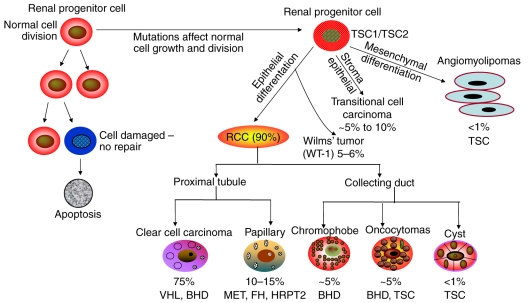Fig. 4.
Schematic summary of genes regulating renal cell carcinoma (RCC) in mammalian kidney. Kidney tissues are made up of many types of cells. These cells grow and divide in a controlled way to produce more cells as they are needed to keep the kidney healthy. When normal cells are damaged beyond repair, they are eliminated by apoptosis. When the genetic material of a cell is altered, cells avoid apoptosis and continue to multiply in an unregulated manner, accumulating mutations that affect normal cell growth and division and resulting in tumor formation. Model shows the renal tumors caused by mutation of the different genes. Renal progenitor cells are regulated by TSCs (tuberous sclerosis complex; TSC1 and TSC2) that are able to differentiate into either mesenchymal or epithelial cells. Mutations in TSC1 or TSC2 cause either mesenchymal (oncocytomas and cyst) or epithelial (angiomyolipomas) tumors. However, most of the common tumors are epithelial RCC type. RCC originates primarily in the proximal renal tubules and, rarely, in collecting ducts. These tumors are clear cell carcinoma, papillary, chromophobe or oncocytomas. Some of the tumors are of epithelial origin and are seen, only seen in children (Wilms' tumor); some of the tumors are also caused by the combination of both epithelial and stroma cells (transitional cell carcinomas).

